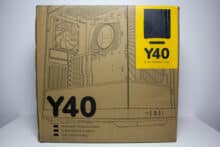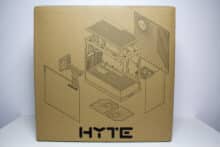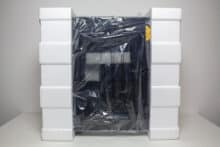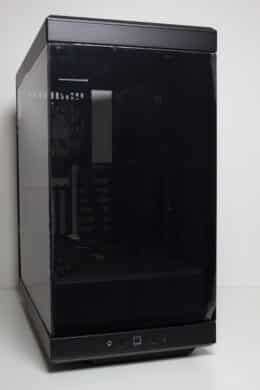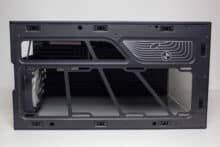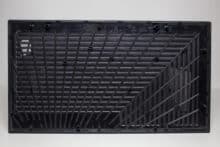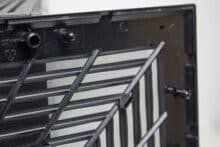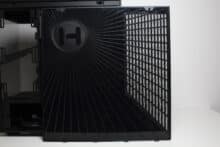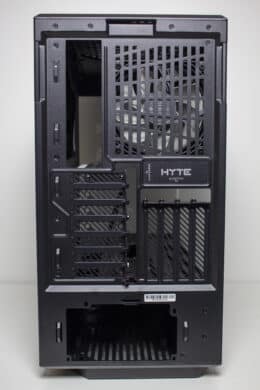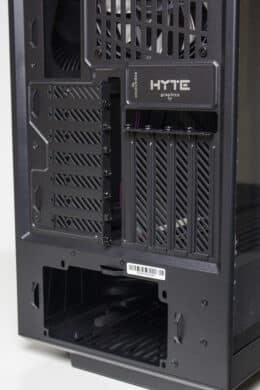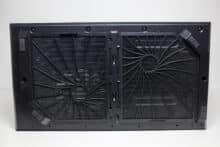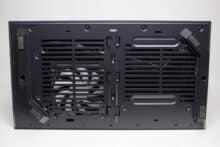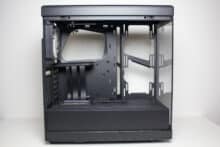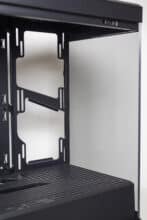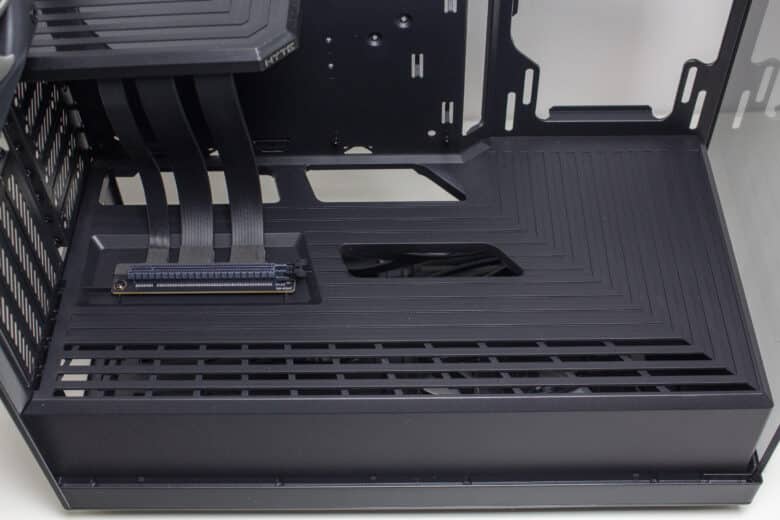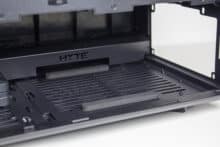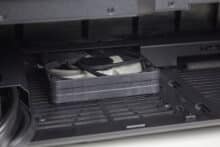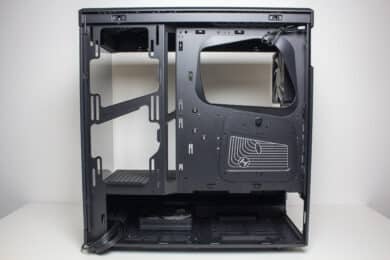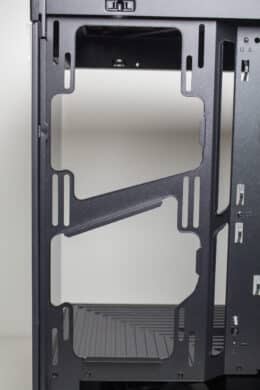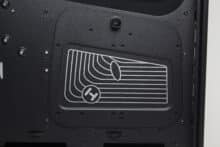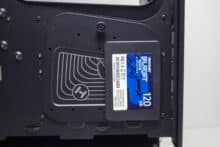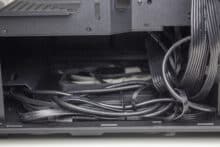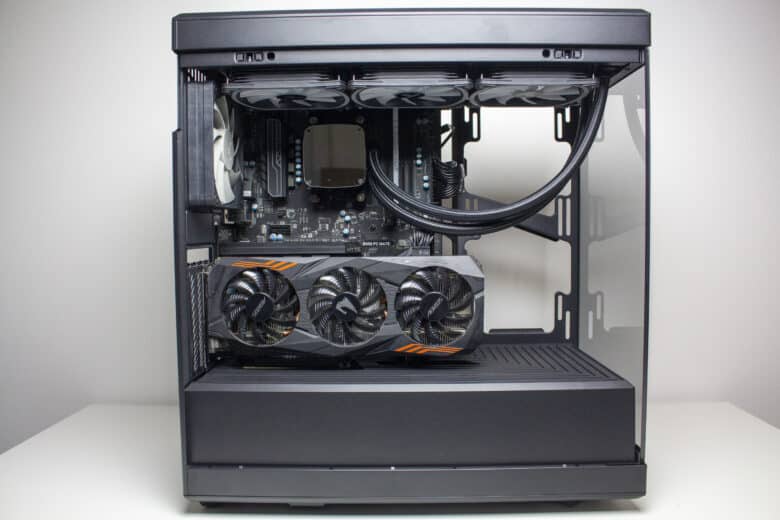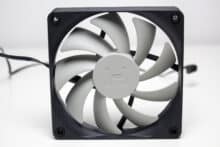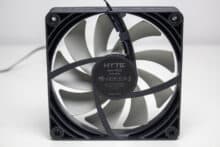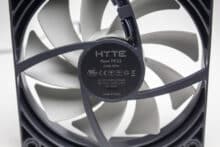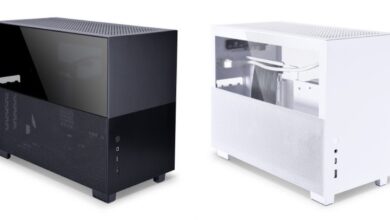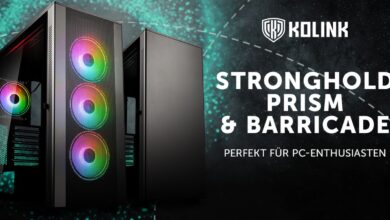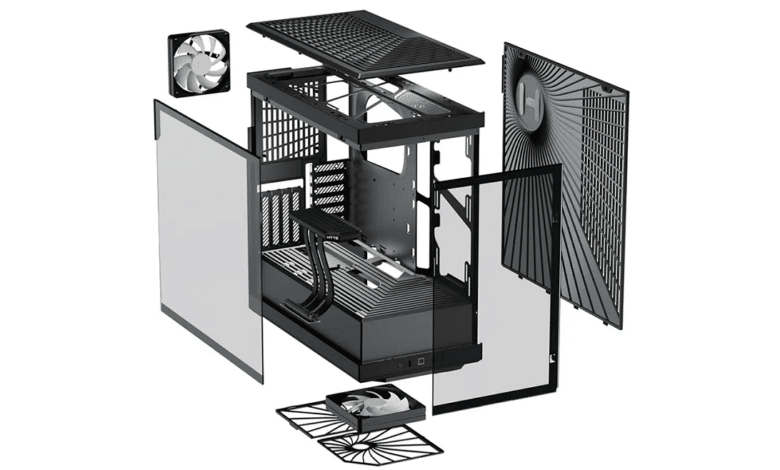
Behind the HYTE brand is a subsidiary of the system integrator iBUYPOWER, which normally offers an extensive portfolio of high-quality, pre-configured PC systems. Via the HYTE brand, the manufacturer is now also trying to make a name for itself on the highly competitive market for PC components as well as accessories. This has already worked well with the HYTE Revolt 3 and Y60 cases, which we have already tested. At CES 2023, the manufacturer has now introduced the HYTE Y40, which we will take a closer look at in this review.
The HYTE Y40 is the smaller brother of the Y60, which caused a stir with its angled glass. With the Y40, HYTE does without such a curvature and relies on two conventional panes in the front and the side. In return, however, the midi tower is supposed to offer plenty of space for air and water cooling systems, have a high-quality build, and provide an interesting look thanks to a combination of straight and odd-shaped guides. However, it’s worth noting that the Y40 comes with a riser card (PCIe 4.0 x16) ex-factory, which allows the GPU to be mounted vertically. This is important because this midi tower does not allow vertical GPU mounting. But let’s start with the technical details.
Technical Details
| Model: | HYTE Y40 black |
| Case Type: | ATX |
| Dimensions: | 240 mm (W) x 472 mm (H) x 439 mm (D) |
| Weight: | 9.6 kg |
| Material: | Steel, plastic, tempered glass |
| Color: | Black |
| Front connectors | 1x USB 3.1 Type-C, 2x USB 3.0 Type-A, 1x HD audio combo port |
| Drive bays: | 1x 3.5″/ 2x 2.5″ |
| Expansion slots: | 6x horizontal (low profile), 4x vertical (riser card, PCIe 4.0 x16) |
| Form Factors: | ATX, mATX, ITX |
| Ventilation: | Tail: 1x 120 mm Lid: 3x 120 mm Side: 2x 120 /140 mm Bottom: 1x 120/ 140 mm |
| Radiators: | Tail: 1x 120 mm Lid: 1x 240/ 360 mm Side: 1x 240/ 280 mm |
| Max. CPU cooler height: | 183 mm |
| Max. Graphics card length: | 422 mm |
| Max. Net part length: | 224 mm |
| Cable management space: | circa 27 mm |
| Price: | € 129.90 * |
| Features: | Dust filter, Cable management, 2x pre-installed 120mm fans, Tempered Glass (front, side), Riser Card (PCIe 4.0 x16) included in accessories, Graphics card mounting vertical only |

HYTE Y40 review: the scope of delivery
As we know it from HYTE, the case is also packed in a cardboard box, but in which, in favor of the price and to protect the environment, colored printing was omitted. Instead, the manufacturer sticks a yellow sticker on the packaging, which indicates the manufacturer and case name as well as the color variant. Otherwise, technical drawings as well as all relevant technical data and the most important key features are found on the box. Inside the packaging, HYTE relies on two blocks of hard styrofoam, a protective film, and protective stickers on both glass panels.
HYTE has hidden the accessories in a brown cardboard box below the power supply cover. In addition to all the screws needed to mount the components, this also contains assembly instructions with pictures and text, as well as a splitter for the combined headphone and microphone connection. A very high-quality riser card (PCI 4.0 x16) is also part of the scope of delivery and was pre-installed by HYTE and protected from damage by soft foam. Lastly, two pre-installed 120mm fans are also included.
Exterior impression
The exterior of the HYTE Y40 is dominated by a lot of glass and panels with large, linear vents. Thus, the front is made of tempered glass, which has been slightly darkened and framed at the top and bottom by the steel frame of the body. If necessary, the front panel can also be removed by removing several screws. However, there is no need for this. HYTE also places the I/O panel in the lower front. There are one USB 3.1 Type-C and two USB 3.0 Type-A ports, an HD audio combo port and power button, which is illuminated in white.
The lid is made of steel, which has been reinforced on the inside with an additional layer of plastic and equipped with an integrated dust filter frame. The large ventilation strips should allow the warm air from the inside to be removed without any problems. The lid plate is attached via push pins and can thus be removed without tools. Below the lid plate we meet the body and various mounting points for three 120 mm or one 360 mm radiator. Since the latter would cover the upper connectors of the motherboard, HYTE also provides the Y40 with an opening through which the motherboard connectors can be reached.
The left side of the case is made of slightly darkened Tempered Glass and is attached via push pins. To remove it, you simply have to pull a bit harder in the back area of the panel and can take it off that way. The right side panel of the Y40 is made of conventional steel and has a large fan grille, which is protected by a non-modular dust filter. For a nice visual effect, the lid’s elongated vents continue on the right side panel, changing direction at a 90-degree angle and ending at the rear of the midi tower. HYTE has also glued a panel of plastic on the inside of the panel, into which the manufacturer’s logo has been pressed.
The back of the Y40 shows a design that is completely different from a conventional midi tower. The case only has six horizontal PCI slots at the back, which are only half the height (low profile). In return, there are four vertical slot panels with full height. What doesn’t deviate from the standard is the mounting position of the power supply, which is installed at the bottom. Above the expansion slots you can also find the first pre-installed 120 mm case fan.
On the bottom, we continue with a special design of the dust filters. These consist of a very fine mesh, which has been stretched on a frame. Unlike the straight lines in the lid, the two plastic grids have been designed in the shape of a spiral. However, it is a bit strange that the dust filters have to be removed in different directions. The latter could be due to the design of the two large feet. Because these are not straight either, but bent on one side. Plastic and a layer of rubber for vibration reduction are used as materials.
Interior impression
Unlike the Y60, HYTE relies on a typical interior layout for the Y40. This is divided into a large chamber for the main components as well as a separated power supply chamber in the lower area. The mainboard tray has been designed flat and has three large openings for routing the power supply cables. To the right of the mainboard tray, HYTE equips the Y40 with a mounting frame for two 120 or 140 mm fans or corresponding radiators.
If you lower your gaze, you’ll find the PSU cover, which hides the PSU and its cables as well as serves as a mounting place for the GPU riser card. Unfortunately, only plastic and no steel is used for the cover. However, the look of the material is okay. Finally, HYTE has provided the top side of the cover with numerous openings for cables as well as ventilation strips.
Below the PSU cover, the PSU and the second pre-installed 120 mm fan find their place. The PSU rests on two elongated strips of foam rubber for decoupling. The fan is placed in front of it and can be replaced by a 140 mm model if necessary. To prevent the power supply cables from getting caught in the fan, HYTE has added a cable channel with numerous eyelets for cable ties.
There is a lot of space for cables at the back with about 27 millimeters. This space is supplemented by numerous eyelets for cable ties. Otherwise, there are no special or noteworthy features.
Unfortunately, the HYTE Y40 doesn’t offer that much space for data media. Either two 2.5″ or one 3.5″ data carrier can be attached to the interestingly designed mounting plate at the back of the motherboard tray. The mounting of the plate is done without tools, but the locking of the media requires the use of screws.
Workmanship
As we were used to from the previous HYTE cases, the Y40 also knows how to convince in terms of build quality as well as haptics. We could not find any paint defects, sharp edges or other material flaws in the entire case. The general material impression and the feel of the modular components are also very good. If we were to find fault with anything, it would be the choice of material for the power supply cover. Given the estimated price, a steel cover would have been quite desirable.
HYTE Y40 review: installation of the components
Now we come to the system installation in the HYTE Y40 test. For hardware, we use a AMD Ryzen 5 1400 on a MSI B350 PC Mate with 16GB Crucial Ballistix Sport LT gray DDR4-2666. The Ryzen is cooled by an LC-Power Cosmo Cool LC-CC-120-RGB and is overclocked to 3.8 GHz (1.25 V). A GTX 1060 6GB from Gigabyte AORUS is responsible for the image output. The power supply is handled by the fully modular LC-Power LC550 V2.31 Platinum with an 80 Plus Platinum efficiency rating.
Installation of all the main components and their cabling was simple and quick. Both in front of and behind the motherboard tray, there is enough room to work even for large hands. In addition, the 27 millimeters of space on the back are more than enough to route thicker cables without any problems. However, cable management in the PSU compartment was a minor challenge. Due to the existence of a fan, we had to accurately ensure that none of the cables got caught in the fan blades. Especially with longer power supplies, this could be more difficult.
The fact that there is a lot of space in the HYTE Y40 is also reflected in the hardware compatibility. There is a remarkable 183 millimeters of space available for air coolers and a very good 422 millimeters for graphics cards. In addition, the GPU can be up to 94 millimeters deep. That is more than enough space even for an RTX 4090 and all purchasable air coolers. Due to the fan in the bottom, the PSU should not be longer than 224 millimeters.
However, the Y40 can also accommodate a water cooler well. Thus, a 360 mm radiator fits in the lid and a 280 mm one on the side, which can also be up to 120 millimeters thick. In our case (Enermax AQUAFUSION ADV 360), we didn’t even have to remove the rear fan. However, the combination of radiator and fan in the lid should not be thicker than 52 millimeters.
From the factory, the HYTE Y40 comes with two pre-installed case fans in the bottom as well as on the back. Both fans have a frame width of 120 millimeters and have been designed to be plain. The frame is black and the rotor, with its nine fan blades, is kept gray. The maximum speed of both fans is specified by the manufacturer with 1300 revolutions per minute. The connection to the motherboard is made in each case via a black cable with a 3-pin connector.
Finally, we come to the temperatures that were reached in the HYTE Y40. During the stress test, Prime95 and FurMark were run for 15 minutes at a room temperature of 20 °C. Furthermore, the test was performed with four different scenarios.
Scenario |
Temperature |
| CPU: 50% PWM (950rpm) GPU: 50% PWM (1650rpm) Open-air benchtable (no additional fans) |
CPU: 65.1 °C GPU: 58.2 °C |
| CPU: 50% PWM (950 rpm) GPU: 50% PWM (1650 rpm) 2x 120mm 7V (950 rpm) |
CPU: 73.3 °C GPU: 68.3 °C |
| CPU: 50% PWM (950 rpm) GPU: 50% PWM (1650 rpm) 2x 120mm 12V (1375 rpm) |
CPU: 71.2 °C GPU: 66.2 °C |
| CPU: 50% PWM (950 rpm) GPU: 50% PWM (1650 rpm) 1x 120mm 7V (950 rpm) Without fan in the bottom |
CPU: 74.3 °C GPU: 70.3 °C |
| CPU: 50% PWM (950 rpm) GPU: 50% PWM (1650 rpm) 2x 120mm 12V PWM (1375 rpm) Without side window |
CPU: 68 °C GPU: 60 °C |
After the temperature measurements, it becomes apparent that things can definitely get a bit warmer in the HYTE Y40 with the default configuration, and that’s despite the fact that the components being operated aren’t exactly known as power hogs. If you run the fans at their maximum speed, the temperatures can be lowered by two degrees on average, but you get a clearly audible noise. A deactivated fan in the bottom increases the maximum values of CPU and GPU by another two degrees.
If you choose the HYTE Y40, we recommend to use two intake fans in the area next to the motherboard tray. The fan in the bottom will most likely not manage to sufficiently cool a GPU with higher power consumption due to the rather restrictive design of the PSU cover.
HYTE Y40 review: conclusion
HYTE has managed to develop an interesting and visually appealing midi tower with its third case as well. By using two glass panels, the Y40 allows deep insights and can certainly attract all eyes with installed RGB components. In addition, the combination of straight and odd lines of the other case elements make for a refreshing appearance. However, the vertical GPU mounting and the included PCIe 4.0 riser card, which can convince with an excellent build quality, are particularly noteworthy. The overall package is rounded off by a solid build quality, a very good amount of space and two pre-installed case fans.
However, their design offers first room for criticism. Due to the light gray fan blades, they may not really blend in well visually in any system. Copies with black rotors would have been much more neutral and fitting here. Furthermore, it was noticeable that the right side panel was slightly pushed outwards by the power supply cables behind it due to the push pins and rattled when touched. We also find it a bit of a shame that HYTE opted for plastic for the PSU cover. Steel would probably have made the midi tower much heavier. The cooling performance of the HYTE Y40 is okay out of the box, but not outstanding.
With an MSRP of €149.90, the HYTE Y40 is also not exactly one of the cheap cases. However, it basically offers a lot when you consider that the riser card alone could cost around 70 to 80€ in the delivered quality. Together with the very good workmanship, an excellent look and hardware compatibility, the HYTE Y40 is a recommendable case.
HYTE Y40
Workmanship
Structure
Features
Cooling
Value for money
90/100
The HYTE Y40 is a visually appealing and solidly manufactured case that convinces with excellent hardware compatibility and a pre-installed PCIe 4.0 riser card. However, additional case fans should be invested in for high-end systems.



